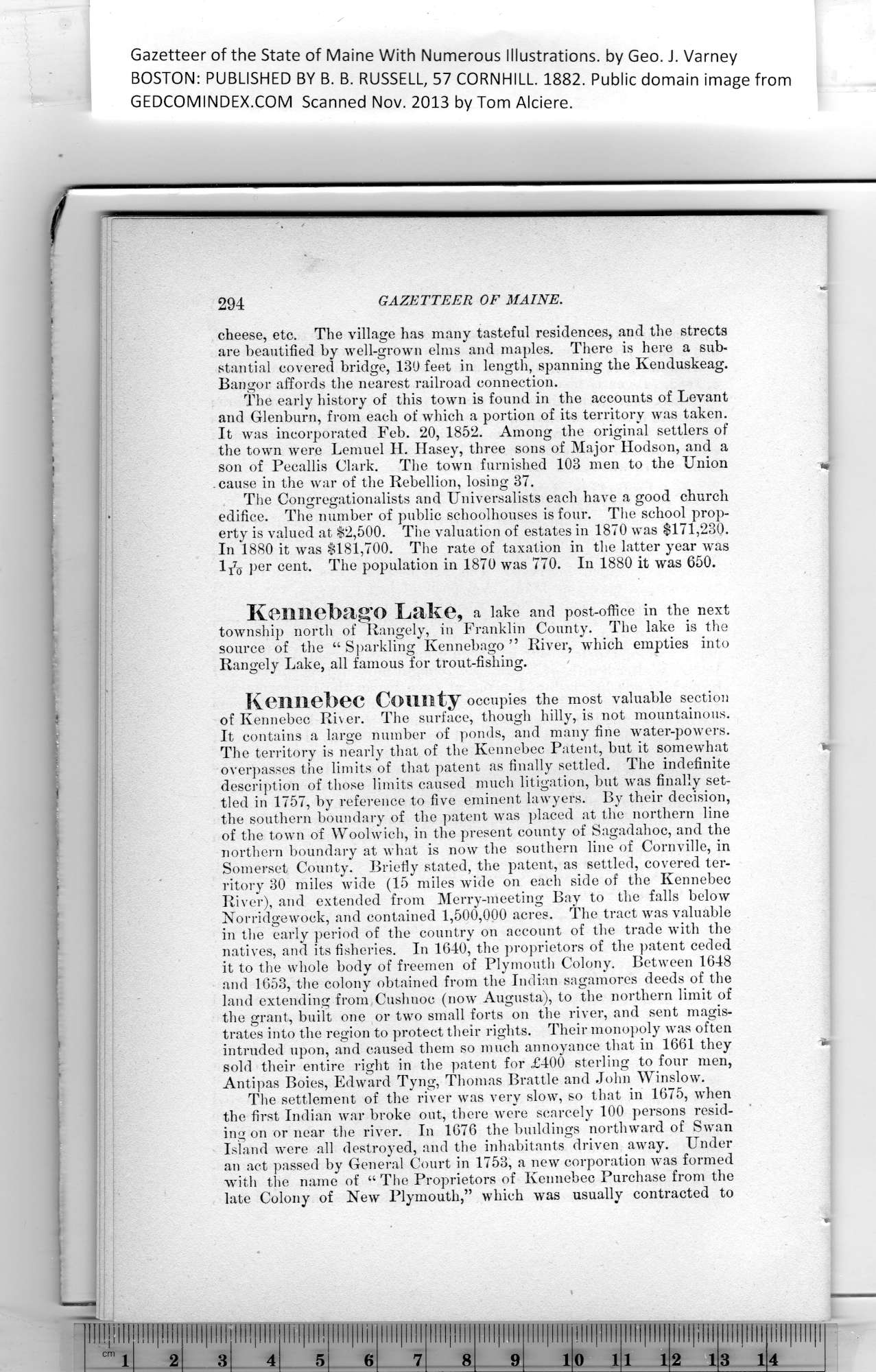|
Gazetteer of the State of Maine With Numerous Illustrations, by Geo. J. Varney
BOSTON: PUBLISHED BY B. B. RUSSELL, 57 CORNHILL. 1882. Public domain image from
294 GAZETTEER OF MAINE.
cheese, etc. The village has many tasteful residences, and the streets
are beautified by well-grown elms and maples. There is here a sub-
stantial covered bridge, 130 feet in length, spanning the Kenduskeag.
Bangor affords the nearest railroad connection.
The early history of this town is found in the accounts of Levant
and Glenburn, from each of which a portion of its territory was taken.
It was incorporated Feb. 20, 1852. Among the original settlers of
the town were Lemuel H. Hasey, three sons of Major Hodson, and a
son of Pecallis Clark. The town furnished 103 men to the Union
.cause in the war of the Rebellion, losing 37.
The Congregationalists and Universalists each have a good church
edifice. The number of public schoolhouses is four. The school prop-
erty is valued at $2,500. The valuation of estates in 1870 was $171,230.
In 1880 it was $181,700. The rate of taxation in the latter year was
Ifrj Per cent. The population in 1870 was 770. In 1880 it was 650.
Kennebago Lake, a lake and post-office in the next
township north of Rangely, in Franklin County. The lake is the
source of the “ Sparkling Kennebago ” River, which empties into
Rangely Lake, all famous for trout-fishing.
Kennebec County occupies the most valuable section
of Kennebec River. The surface, though hilly, is not mountainous.
It contains a large number of ponds, and many fine water-powers.
The territory is nearly that of the Kennebec Patent, but it somewhat
overpasses the limits of that patent as finally settled. The indefinite
description of those limits caused much litigation, but was_finally set-
tled in 1757, by reference to five eminent lawyers. By their decision,
the southern boundary of the patent was placed at the northern line
of the town of Woolwich, in the present county of Sagadahoc, and the
northern boundary at what is now the southern line of Cornville, in
Somerset County. Briefly stated, the patent, as settled, covered ter-
ritory 30 miles wide (15 miles wide on each side of the Kennebec
River), and extended from Merry-meeting Bay to the falls below
Norridgewock, and contained 1,500,000 acres. The tract was valuable
in the early period of the country on account of the trade with the
natives, and its fisheries. In 1640, the proprietors of the patent ceded
it to the whole body of freemen of Plymouth Colony. Between 1648
and 1653, the colony obtained from the Indian sagamores deeds of the
land extending from Cushnoc (now Augusta), to the northern limit of
the grant, built one or two small forts on the river, and sent magis-
trates into the region to protect their rights. Their monopoly was often
intruded upon, and caused them so much annoyance that in 1661 they
sold their entire right in the patent for £400 sterling to four men,
Antipas Boies, Edward Tyng, Thomas Brattle and John Winslow.
The settlement of the river was very slow, so that in 1675, when
the first Indian war broke out, there were scarcely 100 persons resid-
ing on or near the river. In 1676 the buildings northward of Swan
Island were all destroyed, and the inhabitants driven away. Under
an act passed by General Court in 1753, a new corporation was formed
with the name of “ The Proprietors of Kennebec Purchase from the
late Colony of New Plymouth,” which was usually contracted to
PREVIOUS PAGE ... NEXT PAGE
This page was written in HTML using a program written in Python 3.2
|
